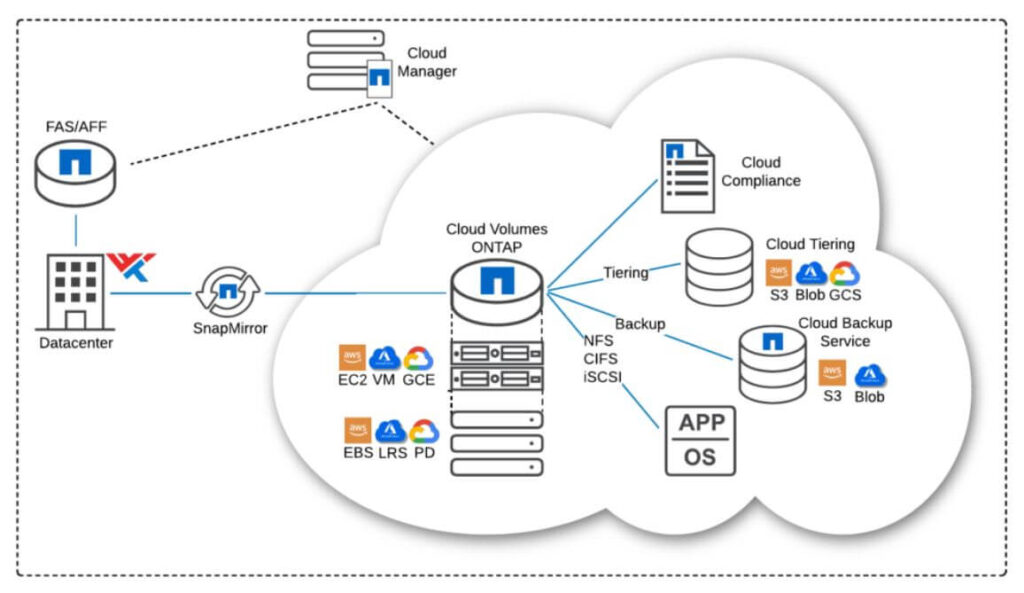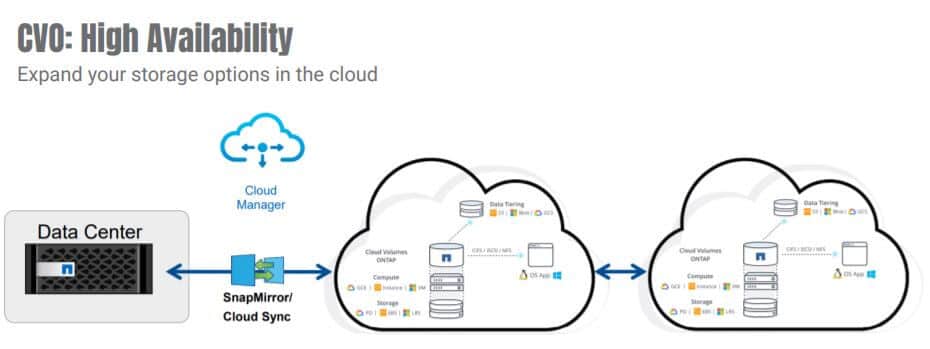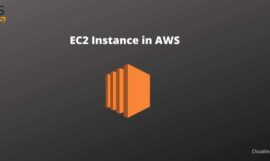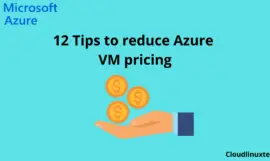This post will cover the requirement to deploy NetApp Cloud Volumes ONTAP (CVO) in Cloud, whether it’s AWS, Azure or Google Cloud (GCP). It will cover all the items, like IAM details, Cloud Manager details, CVO details, CVO Preference, Infrastructure details, Volume details and Deployment service options.
I have struggled a lot to get this information, So decided to write a post and provide this information to the people, who are planning to deploy NetApp Cloud Volumes ONTAP in the cloud.
The requirements to deploy the CVO in AWS, Azure and GCP are more or less the same. Few terms or technology may differ according to Hyperscaler. I have used AWS terms most of the time but you can relate configuration with other cloud vendors easily and select configuration type accordingly.
Note*
You must have some prior knowledge of Cloud and NetApp products to understand this tutorial better. I am hoping, if you are looking for a pre-requisite to deploy CVO in the cloud, you have some knowledge already. Although, I will provide details and sometimes redirect you to the required links, wherever possible for better understanding.
What is Cloud Volumes ONTAP (CVO)
NetApp Cloud Volumes ONTAP (CVO) is a software-defined version (SDS) of ONTAP, allowing you to have the functionality and features of Enterprise data management using Cloud-native storage in Cloud like AWS, Azure and GCP. Mostly all the storage requirements, whether it’s SAN (Storage Area Network), NAS (Network Attached Storage) or Object can be fulfilled using CVO. All the protocols like iSCSI, CIFS, NFS and S3 are supported. The only exception is FC (Fibre Channel), which is not supported and the reason is obvious.
NetApp currently has a strong portfolio and presence in the cloud compared to its competitors. The CVO gives you the flexibility to move data from your on-premise NetApp storage to cloud storage and really beneficial for customers, who have a cloud-first strategy in mind.
Cloud Volumes ONTAP also helps –
- To manage all your storage arrays from single pane of glass using Cloud manager
- Provides you the option of Disaster recovery setup in cloud for your on-premise storage
- Helps you to move your Enterprise applications to Cloud using lift and shift approach, if you have NetApp already as back-end storage
- Faster storage based migration using SnapMirror
- You can use features, like compression, de-duplication to reduce cost in cloud from storage perspective
- Flexclones and snapshots can help you to spin up your Test and Development infrastructure quickly
- Unified storage for SAN,NAS,Object requirements in cloud.

Cloud environment details required for NetApp Cloud Volumes ONTAP
Cloud Environment details
Below mentioned are the Cloud environment details, You would need to deploy CVO in AWS, Azure or GCP. This table asks you to assess, whether your Infrastructure or Landing zone in the cloud is ready to host CVO.
Few options may or may not be applicable to your environment like Data Fabric Networking for inter-region or Cloud to on-prem connectivity. You can simply ignore it.
| Item | Description |
| Account ID | Account ID of environment where CVO will be deployed. For example, AWS account ID |
| IAM Administration Access Available | Confirm administrative access to make required policy and user changes to support CVO deployment |
| Base Cloud Networking Prepared | Cloud networking configurations in place for CVO deployment |
| Data Fabric Networking Established | Inter-region/VPC or Cloud to On-Prem connectivity if needed for Data Fabric relationships (May or may not be applicable in your environment) |
| NetApp Cloud Central Account Ready | NetApp Cloud Central account setup and available |
Cloud Manager details
This section covers all the requirements around Cloud manager. Although the recommendation is to use NetApp SaaS (Software as a Service) to manage your CVO instance in the cloud. But You have the flexibility to deploy your own cloud manager for more control.
What is Cloud manager
Cloud manager is a SaaS-based management platform to manage your NetApp hybrid storage environment. It can centrally manage both Cloud Volumes ONTAP and On-premise NetApp storage seamlessly.
Cloud manager helps to
- Setup and manage Cloud Volumes ONTAP (CVO)
- Setup and use file storage services including Azure NetApp files (ANF), Amazon FSx for ONTAP and Cloud volumes servicess for AWS and GCP.
- Enable integrated software services like Cloud data sense, Cloud insights, Cloud backup service and more.
You can either use the SaaS service of NetApp (Recommended) or can deploy your own cloud manager either in Cloud as VM or On-premise network on a Linux host.
| Network Infrastructure | Description |
| Use Cloud Manager SaaS | Cloud Manager SaaS enables you to automatically access the latest features and to easily switch between your Cloud Central accounts and Connectors. Else you can deploy your own instance for more control |
| Cloud Manager User Access | Confirm Access to Cloud Manager |
| Cloud Manager Account | Account within Cloud Manager |
| Cloud Manager Workspace | Workspace within Cloud Manager where CVO Working Environment will be setup |
| CVO Subscription Added to Cloud Manager | Confirm CVO subscription added to Cloud Manager |
| Add New Connector | Add a new Service Connector or use an existing one |
| Connector Type | Deploy connector in the cloud using Cloud Manager or manually on a Linux host |
| Connector Instance Name | Service Connector name |
| Connector Region | Region for connector deployment |
| Connector VPC/Vnet | VPC or Vnet where Service Connector is deployed |
| Connector Subnet | The subnet where Service Connector is deployed |
Cloud Volumes ONTAP (CVO) details
You have the flexibility to implement CVO as a single node or High Available nodes (2 nodes HA Pair). If you will go with a single node, you don’t need the “Availability Zone” section in the table.
| Type and Licensing | Description |
| Single Node or High Availability | Choose whether CVO will be deployed as a Single Node or as a High Availability 2 node cluster |
| Availability Zone Approach | Multiple AZ enables the selection of 3 separate Subnets/Zones. A Transit Gateway is required to access the floating IP addresses from outside of the VPC in AWS. Not Applicable, if you choose a single node CVO architecture. |
| Licensing Approach | Choose whether CVO will be licensed using the Pay-As-You-Go or Bring Your Own License approach |
| Node Serial Number(s) | Node serial numbers. 1 for Single Node, 2 for HA. (comma-separate) |

Service required to enable Backup, Compliance and monitoring for CVO
Check out these services, which can be enabled for backup, Cloud compliance and Monitoring. Using NetApp Cloud insight, you can get performance insights of your Cloud Volumes ONTAP appliances.
| Services to Enable | Description |
| Backup to Cloud | Integrated backup for Cloud Volumes ONTAP based on SnapMirror and Snapshot technologies. Backup copies are maintained in S3 buckets |
| Cloud Compliance | Demonstrate data compliance and address privacy regulations. Free for the first 1TB, however infrastructure costs will be incurred from the cloud provider |
| Monitoring | Get performance insights for CVO by leveraging NetApp’s Cloud Insights service. Infrastructure costs will be incurred from the cloud provider |
Deployment details
Setup naming convention for your Cluster and be ready with Region and VPC or Virtual network details to deploy CVO.
| Deployment Detail | Description |
| Working Environment (Cluster) Name | Name of Working Environment in Cloud Manager which will also be the ONTAP Cluster Name |
| Region | The region where CVO will be deployed |
| VPC (Virtual Private Cloud) or Virtual network | VPC or Virtual network in which CVO will be deployed |
Security requirements for Cloud Volumes ONTAP (CVO)
In this section, let’s review the security requirements. Cloud manager generates security group for management and data interface but you can use existing security group also if you have one already.
For the SSH authentication method, you can go with a password or key-pair method (recommended). Keep your Key-pair file handy during CVO deployment.
You can go with either Managed or no Encryption (None) as per your environment requirements for Cloud Volumes ONTAP data.
| Security | Description |
| Generate Security Group | Allow Cloud Manager to generate a Security Group allowing management and data interface. |
| Existing Security Group Name or ID | Specify an existing Security Group to use, in case don’t want to generate a new one. |
| SSH Authentication Method | Choose between Password or Key Pair approach to access CVO for SSH administration |
| Key Pair | Specify the Key Pair Name that will be used |
| Data Encryption Method | None, Managed |
Cloud Volumes ONTAP nodes requirements
Below mentioned are the requirements for Subnet and IPs for each node and mediator for cloud volumes ONTAP deployment. In the case of a Single Node, You just need one subnet, Cluster management, Node2, Mediator subnets are not required, obviously.
| Nodes and Networking | Subnet | Detail | Floating IPs | Specify the Subnets where CVO will be deployed. When the Multiple Availability Zone option is selected, your VPC must have 3 subnets, each in a separate Availability Zone. Floating IP Addresses require a Transit Gateway to be reachable from outside of the VPC. You will select the Routing Table(s) to add the floating IP addresses to during deployment. |
| Node 1 | Cluster Management: | |||
| Node 2 | NFS CIFS 1: | |||
| Mediator | NFS CIFS 2: | |||
| N/A | SVM Management: |
Cloud Volumes ONTAP deployment preferences
| CVO Preferences | Description |
| Preconfigured Package | Select from pre-configured packages to suit most needs. |
| ONTAP Version | The version of ONTAP to deploy. In order to select a specific version during the deployment workflow, the Customize option must be selected |
| CVO License | Select one of the three license types. Explore has a max capacity of 2TB, Standard a max capacity of 10TB, and Premium a max capacity of 384TB |
| Instance Type | The CVO License option dictates the available Instance Types to select from. Instance Types incur differing charges from the cloud provider |
| Disk Type | Select the Disk Type to be used for the initial aggregate |
| Disk Size | Select the Disk Size to be used |
| Data Tiering | Cold data from volumes on the initial aggregate can be tiered to S3 storage. You can choose a specific tiering policy when you create or edit a volume. |
| Storage Class for Tiered Data | Amazon S3 offers a range of storage classes designed for different use cases. Visit https://aws.amazon.com/s3/storage-classes/ for more information. |
| Instance Tenancy | A shared instance shares hardware with other AWS accounts. A dedicated instance runs in a VPC on hardware that is isolated from other AWS accounts. |
| Write Speed | With Normal, data is written directly to disk reducing the likelihood of data loss in the event of an unplanned system outage |
Just check out these different pre-configured packages and select as per your requirements. In the CVO license, you can always select from standard, explore or Premium based on your requirements. For Azure and GCP, select instance type accordingly e.g DS, E series or n1,n2 series.
Note*
All the provided pre-configured packages in this post shows minimum or recommended parameters to start with, but you always have the option to resize it. For example, in Disk size, you have the option to select 100GB to 8TB.
POC and Small Workloads
| CVO Preferences | Detail |
| Preconfigured Package | 1. POC and Small Workloads |
| ONTAP Version | Most Current |
| CVO License | Explore |
| Instance Type | m5.xlarge |
| Disk Type | GP2 – General Purpose SSD |
| Disk Size | 500GB |
Cost Effective DR (Disaster Recovery)
| CVO Preferences | Detail |
| Preconfigured Package | 3. cost-effective DR |
| ONTAP Version | Most Current |
| CVO License | Standard |
| Instance Type | m5.2xlarge |
| Disk Type | ST1 – Throughput optimized HDD |
| Disk Size | 1TB |
High-performance production workloads
| CVO Preferences | Detail |
| Preconfigured Package | 4. High-performance production workloads |
| ONTAP Version | Most Current |
| CVO License | Standard |
| Instance Type | r5.2xlarge |
| Disk Type | GP2 – General Purpose SSD |
| Disk Size | 8TB |
Custom configuration
You are free to select options available on respective hyperscaler.
| CVO Preferences | Detail |
| Preconfigured Package | 5. Custom configuration |
| ONTAP Version | As per requirement |
| CVO License | standard, premium or explore |
| Instance Type | As per requirement |
| Disk Type | A per requirement |
| Disk Size | As per requirement |
Volume and Protocol requirement specification for Cloud Volumes ONTAP
This section covers requirements to implement different protocols like NFS, CIFS and iSCSI in Cloud volumes ONTAP deployment.
For NFS protocol
| Initial Volume | Detail | Description |
| Volume Name | Specify a name to be used for your initial volume | |
| Volume Size | Volume Size in GB (Volume automatically grows upon usage) | |
| Protocol | NFS | Choose the protocol to use for the initial volume |
| Access Control | Custom export policy | Choose to make the volume available for client access or not |
| Custom Export Policy Client Match | Comma-separated values include: IPs, IPs with subnet mask or netmask, netgroups, domains, or hostnames | |
| NFS Version | Both NFSv3 & NFSv4 | NFS Version(s) to Enable |
| N/A | N/A | |
| Storage Efficiency | Enabled | Enable thin provisioning, deduplication, and compression |
| Volume Tiering Policy | All | All – Immediately tiers all data (not including metadata) to object storage. |
For CIFS protocol
| Initial Volume | Detail | Description |
| Volume Name | Specify a name to be used for your initial volume | |
| Volume Size | Volume Size in GB (Volume automatically grows upon usage) | |
| Protocol | CIFS | Choose the protocol to use for the initial volume |
| Share Name | Name of CIFS Shares to use. _share will be auto appended to volume name by default | |
| Users / Groups | Everyone; | Valid users and groups separated by a semicolon |
| Permissions | Full Control | Share permissions |
| Active Directory Domain | Domain Name for CIFS Active Directory Join | |
| Storage Efficiency | Enabled | Enable thin provisioning, deduplication, and compression |
| Volume Tiering Policy | All | All – Immediately tiers all data (not including metadata) to object storage. |
For iSCSI
| Initial Volume | Detail | Description |
| Volume Name | Specify a name to be used for your initial volume | |
| Volume Size | Volume Size in GB (Volume automatically grows upon usage) | |
| Protocol | ISCSI | Choose the protocol to use for the initial volume |
| Initiator Group | ISCSI Initiator Group Name | |
| Alias | Host Initiator Alias | |
| Operating System Type | Host Operating System type | |
| Host Initiator | Host Initiator | |
| Storage Efficiency | Enabled | Enable thin provisioning, deduplication, and compression |
| Volume Tiering Policy | All | All – Immediately tiers all data (not including metadata) to object storage. |
Infrastructure Services
You will need DNS (Domain Name System) for name resolution and NTP (Network Time Protocol) servers for time synchronization while deploying Cloud Volumes ONTAP.
| Item | Server 1 | Server 2 | Description |
| DNS Servers | DNS and NTP Servers to be used by the CVO environment | ||
| NTP Servers |
Video
How to deploy Cloud Volumes ONTAP using Cloud manager
End Note
I have tried to cover all required details, which you will need before deploying Cloud Volumes ONTAP (CVO) in your cloud environment. Let me know, in case you need further information or need help on any section. Just leave a comment and I will try to help you in the best possible way.
For further details on Cloud Volumes ONTAP or its components. NetApp official documentation can help you further.



